Jianxing Yu
School of Artificial Intelligence, Sun Yat-sen University, Zhuhai 519082, Guangdong Key Laboratory of Big Data Analysis and Processing, 510006, China, Pazhou Lab, Guangzhou, 510330, China
Functional Consistency of LLM Code Embeddings: A Self-Evolving Data Synthesis Framework for Benchmarking
Aug 27, 2025Abstract:Embedding models have demonstrated strong performance in tasks like clustering, retrieval, and feature extraction while offering computational advantages over generative models and cross-encoders. Benchmarks such as MTEB have shown that text embeddings from large language models (LLMs) capture rich semantic information, but their ability to reflect code-level functional semantics remains unclear. Existing studies largely focus on code clone detection, which emphasizes syntactic similarity and overlooks functional understanding. In this paper, we focus on the functional consistency of LLM code embeddings, which determines if two code snippets perform the same function regardless of syntactic differences. We propose a novel data synthesis framework called Functionality-Oriented Code Self-Evolution to construct diverse and challenging benchmarks. Specifically, we define code examples across four semantic and syntactic categories and find that existing datasets predominantly capture syntactic properties. Our framework generates four unique variations from a single code instance, providing a broader spectrum of code examples that better reflect functional differences. Extensive experiments on three downstream tasks-code clone detection, code functional consistency identification, and code retrieval-demonstrate that embedding models significantly improve their performance when trained on our evolved datasets. These results highlight the effectiveness and generalization of our data synthesis framework, advancing the functional understanding of code.
Boosting Fine-Grained Visual Anomaly Detection with Coarse-Knowledge-Aware Adversarial Learning
Dec 17, 2024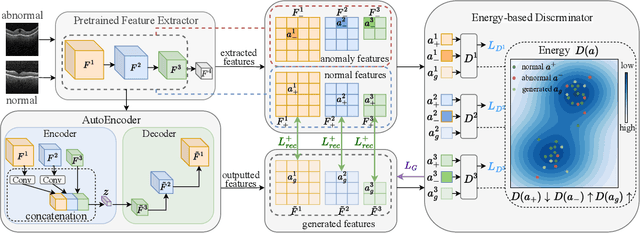
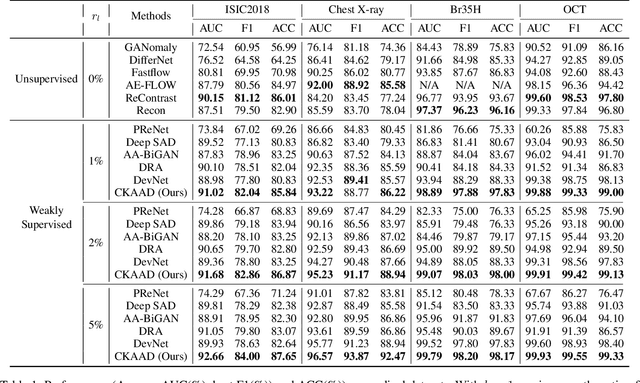


Abstract:Many unsupervised visual anomaly detection methods train an auto-encoder to reconstruct normal samples and then leverage the reconstruction error map to detect and localize the anomalies. However, due to the powerful modeling and generalization ability of neural networks, some anomalies can also be well reconstructed, resulting in unsatisfactory detection and localization accuracy. In this paper, a small coarsely-labeled anomaly dataset is first collected. Then, a coarse-knowledge-aware adversarial learning method is developed to align the distribution of reconstructed features with that of normal features. The alignment can effectively suppress the auto-encoder's reconstruction ability on anomalies and thus improve the detection accuracy. Considering that anomalies often only occupy very small areas in anomalous images, a patch-level adversarial learning strategy is further developed. Although no patch-level anomalous information is available, we rigorously prove that by simply viewing any patch features from anomalous images as anomalies, the proposed knowledge-aware method can also align the distribution of reconstructed patch features with the normal ones. Experimental results on four medical datasets and two industrial datasets demonstrate the effectiveness of our method in improving the detection and localization performance.
Detecting Emotional Incongruity of Sarcasm by Commonsense Reasoning
Dec 17, 2024Abstract:This paper focuses on sarcasm detection, which aims to identify whether given statements convey criticism, mockery, or other negative sentiment opposite to the literal meaning. To detect sarcasm, humans often require a comprehensive understanding of the semantics in the statement and even resort to external commonsense to infer the fine-grained incongruity. However, existing methods lack commonsense inferential ability when they face complex real-world scenarios, leading to unsatisfactory performance. To address this problem, we propose a novel framework for sarcasm detection, which conducts incongruity reasoning based on commonsense augmentation, called EICR. Concretely, we first employ retrieval-augmented large language models to supplement the missing but indispensable commonsense background knowledge. To capture complex contextual associations, we construct a dependency graph and obtain the optimized topology via graph refinement. We further introduce an adaptive reasoning skeleton that integrates prior rules to extract sentiment-inconsistent subgraphs explicitly. To eliminate the possible spurious relations between words and labels, we employ adversarial contrastive learning to enhance the robustness of the detector. Experiments conducted on five datasets demonstrate the effectiveness of EICR.
Multimodal Clickbait Detection by De-confounding Biases Using Causal Representation Inference
Oct 10, 2024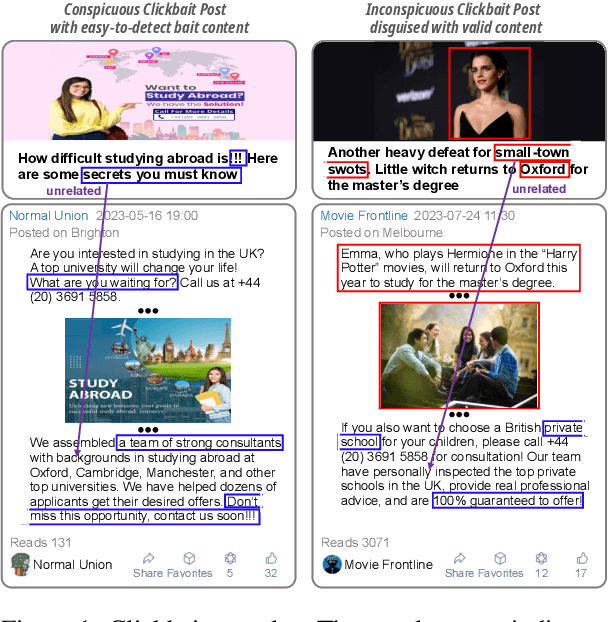

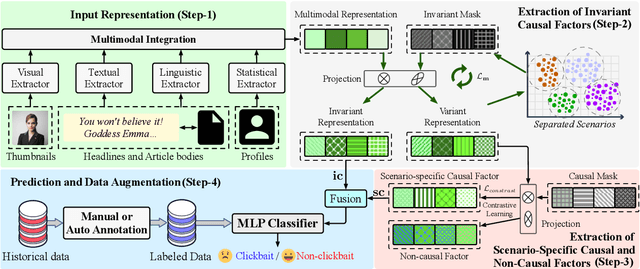

Abstract:This paper focuses on detecting clickbait posts on the Web. These posts often use eye-catching disinformation in mixed modalities to mislead users to click for profit. That affects the user experience and thus would be blocked by content provider. To escape detection, malicious creators use tricks to add some irrelevant non-bait content into bait posts, dressing them up as legal to fool the detector. This content often has biased relations with non-bait labels, yet traditional detectors tend to make predictions based on simple co-occurrence rather than grasping inherent factors that lead to malicious behavior. This spurious bias would easily cause misjudgments. To address this problem, we propose a new debiased method based on causal inference. We first employ a set of features in multiple modalities to characterize the posts. Considering these features are often mixed up with unknown biases, we then disentangle three kinds of latent factors from them, including the invariant factor that indicates intrinsic bait intention; the causal factor which reflects deceptive patterns in a certain scenario, and non-causal noise. By eliminating the noise that causes bias, we can use invariant and causal factors to build a robust model with good generalization ability. Experiments on three popular datasets show the effectiveness of our approach.
VideoQA in the Era of LLMs: An Empirical Study
Aug 08, 2024



Abstract:Video Large Language Models (Video-LLMs) are flourishing and has advanced many video-language tasks. As a golden testbed, Video Question Answering (VideoQA) plays pivotal role in Video-LLM developing. This work conducts a timely and comprehensive study of Video-LLMs' behavior in VideoQA, aiming to elucidate their success and failure modes, and provide insights towards more human-like video understanding and question answering. Our analyses demonstrate that Video-LLMs excel in VideoQA; they can correlate contextual cues and generate plausible responses to questions about varied video contents. However, models falter in handling video temporality, both in reasoning about temporal content ordering and grounding QA-relevant temporal moments. Moreover, the models behave unintuitively - they are unresponsive to adversarial video perturbations while being sensitive to simple variations of candidate answers and questions. Also, they do not necessarily generalize better. The findings demonstrate Video-LLMs' QA capability in standard condition yet highlight their severe deficiency in robustness and interpretability, suggesting the urgent need on rationales in Video-LLM developing.
Answering Subjective Induction Questions on Products by Summarizing Multi-sources Multi-viewpoints Knowledge
Sep 12, 2023Abstract:This paper proposes a new task in the field of Answering Subjective Induction Question on Products (SUBJPQA). The answer to this kind of question is non-unique, but can be interpreted from many perspectives. For example, the answer to 'whether the phone is heavy' has a variety of different viewpoints. A satisfied answer should be able to summarize these subjective opinions from multiple sources and provide objective knowledge, such as the weight of a phone. That is quite different from the traditional QA task, in which the answer to a factoid question is unique and can be found from a single data source. To address this new task, we propose a three-steps method. We first retrieve all answer-related clues from multiple knowledge sources on facts and opinions. The implicit commonsense facts are also collected to supplement the necessary but missing contexts. We then capture their relevance with the questions by interactive attention. Next, we design a reinforcement-based summarizer to aggregate all these knowledgeable clues. Based on a template-controlled decoder, we can output a comprehensive and multi-perspective answer. Due to the lack of a relevant evaluated benchmark set for the new task, we construct a large-scale dataset, named SupQA, consisting of 48,352 samples across 15 product domains. Evaluation results show the effectiveness of our approach.
UniDiff: Advancing Vision-Language Models with Generative and Discriminative Learning
Jun 01, 2023Abstract:Recent advances in vision-language pre-training have enabled machines to perform better in multimodal object discrimination (e.g., image-text semantic alignment) and image synthesis (e.g., text-to-image generation). On the other hand, fine-tuning pre-trained models with discriminative or generative capabilities such as CLIP and Stable Diffusion on domain-specific datasets has shown to be effective in various tasks by adapting to specific domains. However, few studies have explored the possibility of learning both discriminative and generative capabilities and leveraging their synergistic effects to create a powerful and personalized multimodal model during fine-tuning. This paper presents UniDiff, a unified multi-modal model that integrates image-text contrastive learning (ITC), text-conditioned image synthesis learning (IS), and reciprocal semantic consistency modeling (RSC). UniDiff effectively learns aligned semantics and mitigates the issue of semantic collapse during fine-tuning on small datasets by leveraging RSC on visual features from CLIP and diffusion models, without altering the pre-trained model's basic architecture. UniDiff demonstrates versatility in both multi-modal understanding and generative tasks. Experimental results on three datasets (Fashion-man, Fashion-woman, and E-commercial Product) showcase substantial enhancements in vision-language retrieval and text-to-image generation, illustrating the advantages of combining discriminative and generative fine-tuning. The proposed UniDiff model establishes a robust pipeline for personalized modeling and serves as a benchmark for future comparisons in the field.
Leveraging Contaminated Datasets to Learn Clean-Data Distribution with Purified Generative Adversarial Networks
Feb 03, 2023


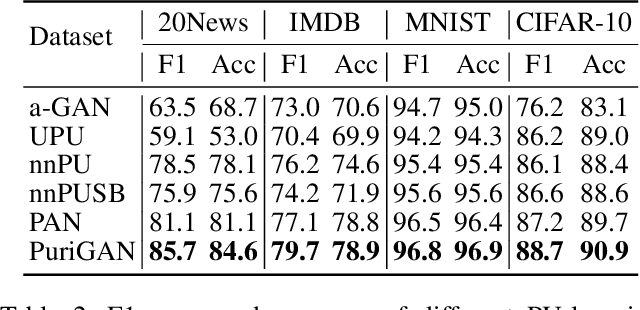
Abstract:Generative adversarial networks (GANs) are known for their strong abilities on capturing the underlying distribution of training instances. Since the seminal work of GAN, many variants of GAN have been proposed. However, existing GANs are almost established on the assumption that the training dataset is clean. But in many real-world applications, this may not hold, that is, the training dataset may be contaminated by a proportion of undesired instances. When training on such datasets, existing GANs will learn a mixture distribution of desired and contaminated instances, rather than the desired distribution of desired data only (target distribution). To learn the target distribution from contaminated datasets, two purified generative adversarial networks (PuriGAN) are developed, in which the discriminators are augmented with the capability to distinguish between target and contaminated instances by leveraging an extra dataset solely composed of contamination instances. We prove that under some mild conditions, the proposed PuriGANs are guaranteed to converge to the distribution of desired instances. Experimental results on several datasets demonstrate that the proposed PuriGANs are able to generate much better images from the desired distribution than comparable baselines when trained on contaminated datasets. In addition, we also demonstrate the usefulness of PuriGAN on downstream applications by applying it to the tasks of semi-supervised anomaly detection on contaminated datasets and PU-learning. Experimental results show that PuriGAN is able to deliver the best performance over comparable baselines on both tasks.
Efficient Document Retrieval by End-to-End Refining and Quantizing BERT Embedding with Contrastive Product Quantization
Oct 31, 2022Abstract:Efficient document retrieval heavily relies on the technique of semantic hashing, which learns a binary code for every document and employs Hamming distance to evaluate document distances. However, existing semantic hashing methods are mostly established on outdated TFIDF features, which obviously do not contain lots of important semantic information about documents. Furthermore, the Hamming distance can only be equal to one of several integer values, significantly limiting its representational ability for document distances. To address these issues, in this paper, we propose to leverage BERT embeddings to perform efficient retrieval based on the product quantization technique, which will assign for every document a real-valued codeword from the codebook, instead of a binary code as in semantic hashing. Specifically, we first transform the original BERT embeddings via a learnable mapping and feed the transformed embedding into a probabilistic product quantization module to output the assigned codeword. The refining and quantizing modules can be optimized in an end-to-end manner by minimizing the probabilistic contrastive loss. A mutual information maximization based method is further proposed to improve the representativeness of codewords, so that documents can be quantized more accurately. Extensive experiments conducted on three benchmarks demonstrate that our proposed method significantly outperforms current state-of-the-art baselines.
Refining BERT Embeddings for Document Hashing via Mutual Information Maximization
Sep 07, 2021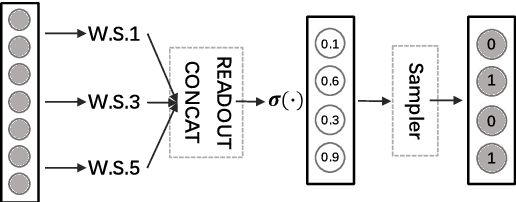
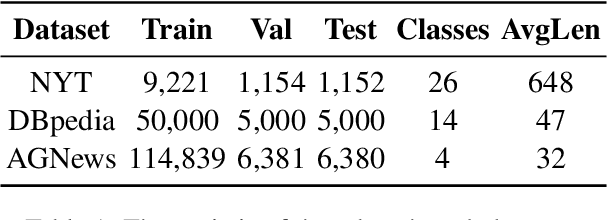
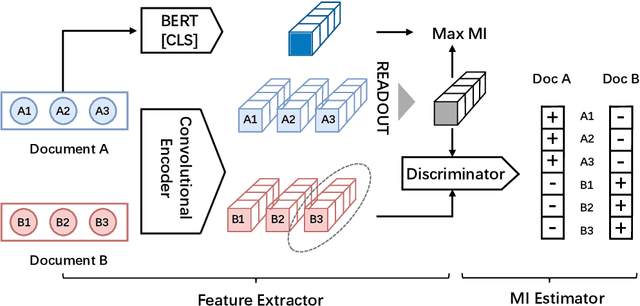

Abstract:Existing unsupervised document hashing methods are mostly established on generative models. Due to the difficulties of capturing long dependency structures, these methods rarely model the raw documents directly, but instead to model the features extracted from them (e.g. bag-of-words (BOW), TFIDF). In this paper, we propose to learn hash codes from BERT embeddings after observing their tremendous successes on downstream tasks. As a first try, we modify existing generative hashing models to accommodate the BERT embeddings. However, little improvement is observed over the codes learned from the old BOW or TFIDF features. We attribute this to the reconstruction requirement in the generative hashing, which will enforce irrelevant information that is abundant in the BERT embeddings also compressed into the codes. To remedy this issue, a new unsupervised hashing paradigm is further proposed based on the mutual information (MI) maximization principle. Specifically, the method first constructs appropriate global and local codes from the documents and then seeks to maximize their mutual information. Experimental results on three benchmark datasets demonstrate that the proposed method is able to generate hash codes that outperform existing ones learned from BOW features by a substantial margin.
 Add to Chrome
Add to Chrome Add to Firefox
Add to Firefox Add to Edge
Add to Edge